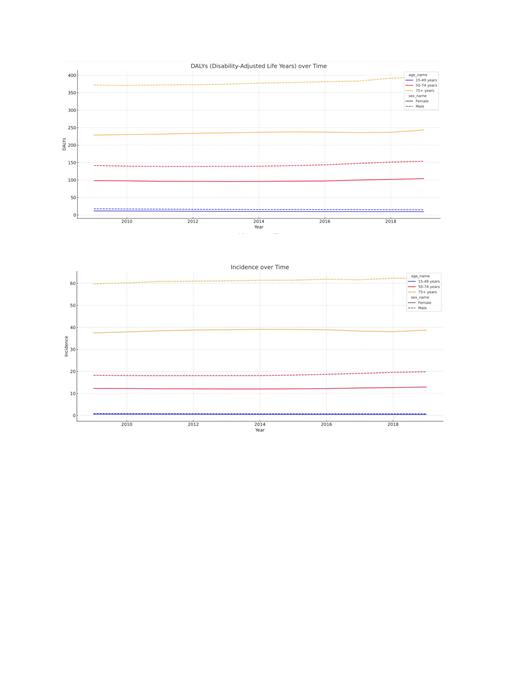Introduction:
In contrast to the global trends, which indicate an escalating incidence and mortality of Multiple Myeloma (MM), the United States presents an inverse scenario. The successful development and deployment of therapeutic interventions have led to an appreciable decrease in mortality by 18%. Among the diverse array of prognostic factors associated with MM, age stands out as a significant element, typically associated with poor prognosis. With these considerations in mind, our study aimed to undertake a systematic analysis of the incidence, mortality, and Disability-Adjusted Life Years (DALY) related to MM over a decade in the United States.
Methods:
The Global Burden of Disease (2019) offers extensive assessments of the incidence, mortality, and DALY in the United States from 1990 to 2019. The data was gathered using the Global Health Data Exchange query tool. We analyzed the annual percentage change (APC) over this period and compared different age groups to enhance the current trend of incidence, mortality, and DALY in the United States between 2009-2019.
Results:
Our analysis was structured around three distinct age groups-15-49 years, 50-74 years, and 75+ years, with each category further stratified by gender. For the 15-49 years cohort, males consistently exhibited higher average Disability-Adjusted Life Years (DALYs) at 15.60 per 100,000, as compared to their female counterparts, who averaged at 10.05. Intriguingly, the Annual Percentage Change (APC) displayed a downward trajectory for DALYs, Deaths, and Incidence rates over the period under study, with respective APC values of -1.79, -1.81, and -1.95. This trend indicates a consistent improvement in health outcomes for this age group.
On the other hand, the 50-74 years age group revealed a significantly ascending trend in all health measures. Here, females and males recorded average DALYs of 98.13 and 143.33 per 100,000, respectively. The APC values for this group underscored an increasing trajectory-0.72 for both DALYs and Incidence and 0.92 for Deaths-signifying a worsening in health outcomes over the duration of observation.
Lastly, in the oldest age group of 75+ years, the DALYs surged to 235.78 for females and 379.87 for males per 100,000. Although the APC values for this age group were positive, they were relatively lower than those for the 50-74 years group, with APC values of 0.62 for DALYs, 0.44 for Deaths, and 0.39 for Incidence.
Conclusion:
New therapies in MM have decreased the average of DALY in the US over the studied decade. Between the ages 15-49 years, the study's results align with the current data correlating younger age with a better prognosis. However, when divided into age categories, the subgroup from 50-74 years showed a possible rapid deterioration in health outcomes when compared with patients above 75 years old. Additional studies are needed to better understand this underlying pathophysiology to have better results and develop further therapies.
Disclosures
No relevant conflicts of interest to declare.


This feature is available to Subscribers Only
Sign In or Create an Account Close Modal